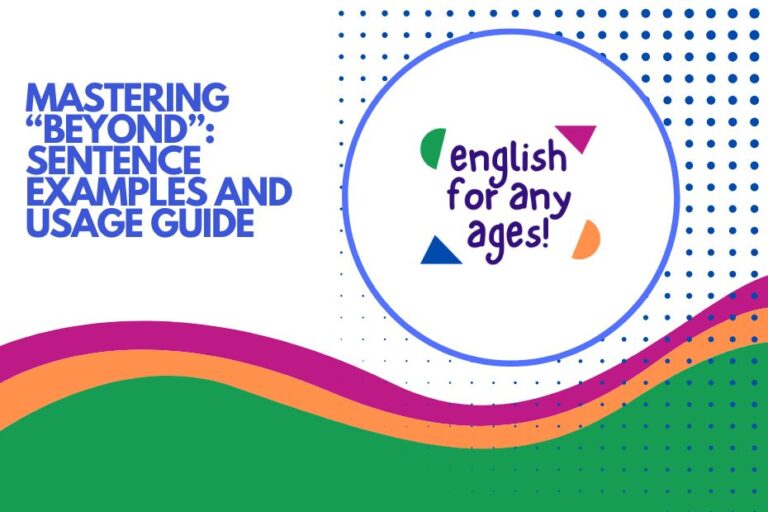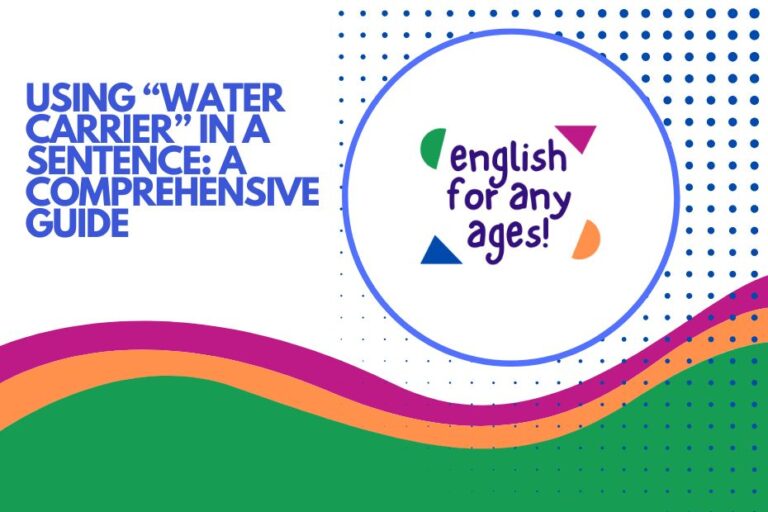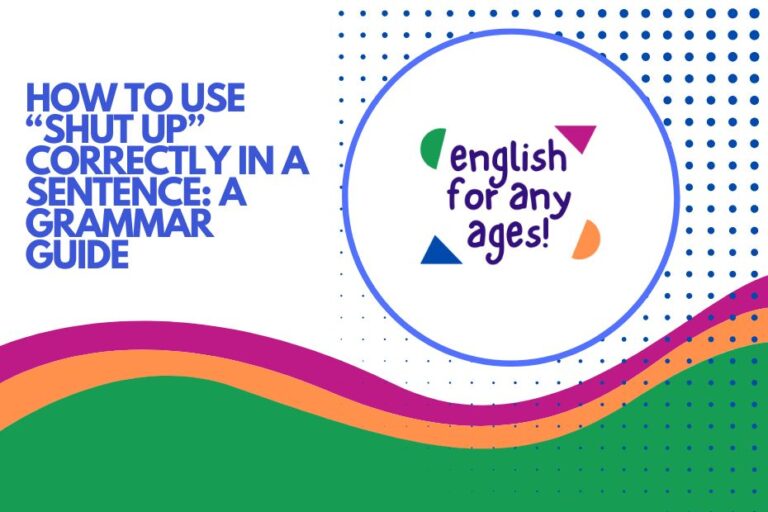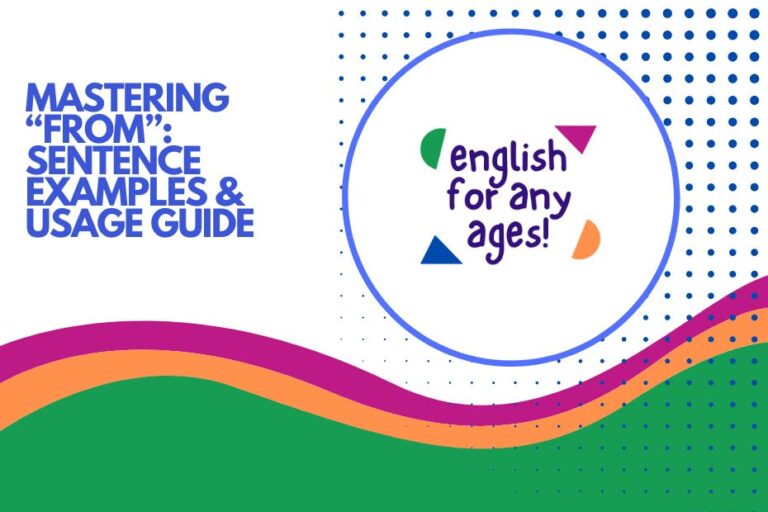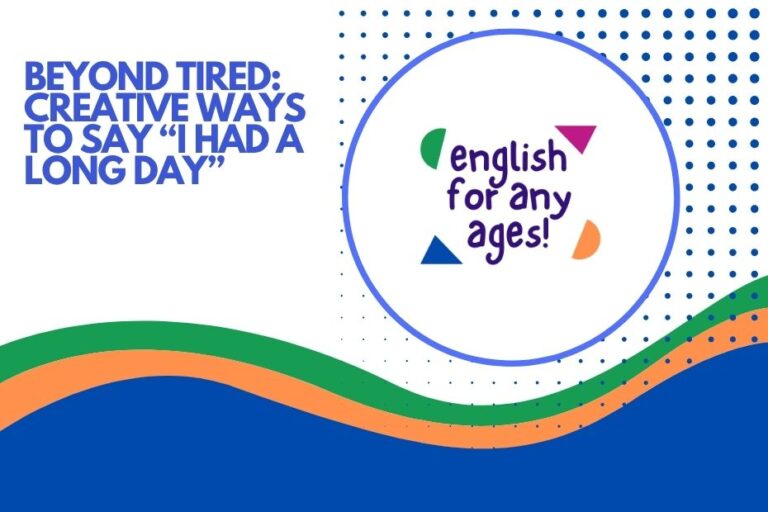Mastering “Below”: Sentence Examples and Usage Guide
The preposition “below” is a fundamental word in English grammar, crucial for indicating spatial relationships, hierarchical positions, and even abstract concepts. Understanding how to use “below” correctly is essential for clear and precise communication.
This article provides a comprehensive guide to using “below” in sentences, covering its definition, structural roles, various contexts, common mistakes, and advanced applications. Whether you are a beginner or an advanced learner, this guide will help you master the nuances of “below” and enhance your English proficiency.
Table of Contents
- Definition of “Below”
- Structural Breakdown
- Types and Categories of Usage
- Sentence Examples
- Usage Rules
- Common Mistakes
- Practice Exercises
- Advanced Topics
- FAQ
- Conclusion
Definition of “Below”
“Below” is a preposition that indicates something is at a lower level or position than something else. It can refer to physical locations, ranks, statuses, or abstract concepts.
Essentially, “below” signifies inferiority or subordination in a given context. It can also be used adverbially, though its primary function is as a preposition.
As a preposition, “below” requires an object, which is the noun or pronoun that it relates to. For instance, in the sentence “The temperature is below freezing,” “freezing” is the object of the preposition “below.” Understanding this relationship is crucial for constructing grammatically correct sentences.
The word “below” is often contrasted with “above.” While “above” indicates a higher position, “below” indicates a lower one. Knowing when to use “below” versus “above” can significantly improve the clarity of your writing and speech.
Furthermore, “below” can sometimes be used figuratively to imply a lack of worth or dignity.
Structural Breakdown
The basic structure of a sentence using “below” as a preposition is: Subject + Verb + below + Object. The object can be a noun, pronoun, or noun phrase. The prepositional phrase “below + object” typically functions as an adverbial modifier, providing information about location, condition, or state.
For example, in the sentence “The basement is below the ground floor,” “the basement” is the subject, “is” is the verb, and “the ground floor” is the object of the preposition “below.” The phrase “below the ground floor” modifies the verb “is,” indicating the location of the basement.
Another structural variation involves using “below” in more complex sentences with clauses. For instance: “The text below the image provides additional information.” Here, “below the image” acts as an adjective modifying “text.” The sentence structure remains consistent, but the function of the prepositional phrase varies depending on the context.
Types and Categories of Usage
The preposition “below” can be categorized based on the type of relationship it describes.
Spatial Relationships
This is the most common usage, indicating a physical location lower than another. Examples include: “The fish swam below the surface,” and “My apartment is below hers.”
Hierarchical Positions
Used to denote a lower rank or status. Examples: “He is below the manager in the hierarchy,” and “The rank of sergeant is below that of a lieutenant.”
Numerical Values
Indicates a quantity less than a specific number. Examples: “The temperature dropped below zero,” and “Scores below 60 are considered failing.”
Abstract Contexts
Refers to concepts like standards or expectations not being met. Examples: “His work was below average,” and “I consider such behavior to be below contempt.”
Weather Conditions
Used to describe conditions, particularly temperature, that are lower than a specified point. Examples: “The temperature dipped below freezing overnight,” and “Conditions are expected to remain below normal for the next week.”
Sentence Examples
Below are several examples of sentences using the preposition “below,” categorized by their usage type. Each table provides a variety of contexts to illustrate the versatility of “below.”
Spatial Relationships
This table illustrates the use of “below” to describe physical locations and spatial relationships. Each sentence provides a clear indication of one object being located at a lower position than another.
| # | Sentence |
|---|---|
| 1 | The submarine traveled below the waves. |
| 2 | The roots of the tree extend far below the surface. |
| 3 | The miners worked deep below the ground. |
| 4 | The basement is located below the main floor. |
| 5 | The valley lies below the mountain peaks. |
| 6 | The fish swam below the boat. |
| 7 | My apartment is below theirs in the building. |
| 8 | The tunnel runs below the riverbed. |
| 9 | The cat hid below the table. |
| 10 | The treasure was buried below the sand. |
| 11 | The bottom shelf is located below the middle shelf. |
| 12 | The drain is below the sink. |
| 13 | The foundation of the house is below ground. |
| 14 | The pipes run below the floorboards. |
| 15 | The submarine dove below the surface of the ocean. |
| 16 | The hidden cave was located below the waterfall. |
| 17 | The lower deck is below the upper deck. |
| 18 | The anchor dropped below the waterline. |
| 19 | The sewer system is located below the streets. |
| 20 | The well extends far below the earth’s surface. |
| 21 | The valley is considerably below the mountain range. |
| 22 | The underground parking is located well below street level. |
| 23 | The cellar is situated below the kitchen. |
| 24 | The aquifer lies far below the surface soil. |
| 25 | The roots of the ancient tree spread below the garden path. |
| 26 | The hidden chamber was found below the old library. |
| 27 | The secret passage started below the fireplace. |
| 28 | The deepest part of the ocean is located far below. |
| 29 | The underground river flowed below the forest. |
| 30 | The rabbit burrowed below the hedge. |
Hierarchical Positions
This table demonstrates the use of “below” to indicate a lower rank, status, or position within a hierarchy. These examples can be applied to organizational structures, social hierarchies, and other ranking systems.
| # | Sentence |
|---|---|
| 1 | He is below the senior manager in the company hierarchy. |
| 2 | The rank of corporal is below that of sergeant. |
| 3 | She reports to the person listed below her on the organizational chart. |
| 4 | As a junior partner, he is below the senior partners in the firm. |
| 5 | The assistant director is below the director in the chain of command. |
| 6 | Privates are below officers in the military structure. |
| 7 | The entry-level position is below the mid-level position. |
| 8 | In the academic hierarchy, a lecturer is typically below a professor. |
| 9 | The vice president is below the president in the corporate structure. |
| 10 | A freshman is below a sophomore in college. |
| 11 | The second tier suppliers are below the first tier suppliers in terms of priority. |
| 12 | In the band, the backup singers are below the lead vocalist. |
| 13 | He is considered below average in terms of performance. |
| 14 | The lower grade students are below the higher grade students in the school. |
| 15 | The apprentice is below the journeyman in skill level. |
| 16 | The probationary employee is below permanent employees in job security. |
| 17 | The less experienced players are ranked below the veterans. |
| 18 | The subordinate is below the supervisor in authority. |
| 19 | The junior editor is below the senior editor in the publishing house. |
| 20 | The assistant coach is below the head coach in the team’s hierarchy. |
| 21 | In the government, the undersecretary is below the secretary. |
| 22 | The associate professor is below the full professor in academic standing. |
| 23 | The second in command is always below the leader. |
| 24 | The lower class is often considered below the upper class in social status. |
| 25 | In a monarchy, the dukes are below the king or queen. |
| 26 | The interns are below the full-time employees in the office. |
| 27 | The assistant manager is below the general manager in the retail chain. |
| 28 | The second violinist sits below the first violinist in the orchestra. |
| 29 | The copy editor is below the managing editor in the editorial process. |
| 30 | The trainee is below the mentor in the program. |
Numerical Values
This table illustrates the use of “below” to indicate that a value is less than a specific number. These examples are commonly used in contexts involving measurements, scores, statistics, and other quantitative data.
| # | Sentence |
|---|---|
| 1 | The temperature dropped below freezing last night. |
| 2 | Any score below 70 is considered a failing grade. |
| 3 | The water level fell below the critical threshold. |
| 4 | His blood pressure was below the normal range. |
| 5 | The stock price dipped below $50 per share. |
| 6 | The unemployment rate remained below 5%. |
| 7 | The company’s profits were below expectations. |
| 8 | The wind chill factor was below zero degrees. |
| 9 | The attendance rate was below 80% this month. |
| 10 | The radiation levels were below the safety limit. |
| 11 | The speed limit is below 30 miles per hour in residential areas. |
| 12 | The sales figures were below the projected forecast. |
| 13 | The poverty line is defined as income below a certain amount. |
| 14 | The test scores were consistently below the average. |
| 15 | The debt-to-income ratio should be below a manageable percentage. |
| 16 | The calorie count was below 200 per serving. |
| 17 | The humidity levels were below the comfort threshold. |
| 18 | The concentration of pollutants was below the permissible level. |
| 19 | The voter turnout was below 60% in the last election. |
| 20 | The interest rate is currently below 3%. |
| 21 | The minimum wage is below the living wage in many areas. |
| 22 | The birth rate has fallen below the replacement level. |
| 23 | The energy consumption was below the projected amount. |
| 24 | The error rate was below 1% in the quality control process. |
| 25 | The noise level was below the legal limit in the residential zone. |
| 26 | The growth rate was below the target set by the government. |
| 27 | The water pressure dropped below the required level. |
| 28 | The crime rate is below the national average in this city. |
| 29 | The carbon emissions were below the agreed-upon reduction target. |
| 30 | The rainfall was below the historical average for this month. |
Abstract Contexts
This table illustrates how “below” is used in abstract contexts to denote a level of quality, behavior, or standard that is considered inadequate or unacceptable. These examples often involve subjective judgments and moral or ethical considerations.
| # | Sentence |
|---|---|
| 1 | His behavior was below acceptable standards. |
| 2 | The quality of the work was below par. |
| 3 | I consider such actions to be below contempt. |
| 4 | The ethics of the situation were below reproach. |
| 5 | Her performance was below expectations. |
| 6 | The level of service was below what we anticipated. |
| 7 | The dialogue in the movie was below average. |
| 8 | Their treatment of the employees was below humane. |
| 9 | The living conditions were below the poverty line. |
| 10 | The level of security was below what was required. |
| 11 | His understanding of the subject matter was below basic. |
| 12 | The taste of the food was below satisfactory. |
| 13 | The moral standards were considered below decent. |
| 14 | The craftsmanship was below what was advertised. |
| 15 | The level of communication was below effective. |
| 16 | The safety measures were below adequate. |
| 17 | His attempts to justify his actions were below convincing. |
| 18 | The respect shown was below minimal. |
| 19 | The support provided was below helpful. |
| 20 | The amount of effort put in was below sufficient. |
| 21 | The level of preparation was below impressive. |
| 22 | The degree of commitment was below admirable. |
| 23 | The standard of cleanliness was below acceptable. |
| 24 | The quality of education was below competitive. |
| 25 | The level of professionalism was below expected. |
| 26 | The fairness of the decision was below questionable. |
| 27 | The level of transparency was below desirable. |
| 28 | The accountability shown was below responsible. |
| 29 | The integrity displayed was below ethical. |
| 30 | The level of compassion was below empathetic. |
Weather Conditions
This table focuses on the use of “below” to describe weather conditions, particularly temperature, that are lower than a specified point. These examples are useful for discussing weather forecasts and climate-related phenomena.
| # | Sentence |
|---|---|
| 1 | The temperature is expected to drop below freezing tonight. |
| 2 | Conditions will remain below normal for the next several days. |
| 3 | The wind chill factor made it feel much colder than below zero. |
| 4 | The average temperature for January is usually below 10 degrees Celsius. |
| 5 | The record low for this date is well below the freezing point. |
| 6 | The frost line is below the surface, so plants are protected. |
| 7 | The water temperature in the lake is below what is comfortable for swimming. |
| 8 | The snowfall was below the expected amount for this time of year. |
| 9 | The humidity level is below the threshold for fog formation. |
| 10 | The UV index is below what is considered harmful today. |
| 11 | The air pressure is below the average for this altitude. |
| 12 | The sea ice extent is below the historical average. |
| 13 | The precipitation level is below what is needed for adequate crop growth. |
| 14 | The cloud cover is below what is typical for a cloudy day. |
| 15 | The visibility is below what is safe for driving in some areas. |
| 16 | The ground temperature is below what is needed for seed germination. |
| 17 | The level of ozone is below what is considered healthy. |
| 18 | The dew point is below the freezing temperature. |
| 19 | The radiative forcing is below what is causing significant climate change. |
| 20 | The amount of sunshine is below what is expected for a summer day. |
| 21 | The atmospheric pressure is below the standard level at sea. |
| 22 | The snow accumulation is below the average for the winter season. |
| 23 | The cooling degree days count is below the historical norm. |
| 24 | The heat index is below the danger threshold. |
| 25 | The air quality index is below the level that poses health risks. |
| 26 | The water table is below the level needed for wetland sustainability. |
| 27 | The soil moisture content is below the optimal level for plant growth. |
| 28 | The solar radiation is below what is needed for efficient solar energy production. |
| 29 | The level of carbon dioxide is below the pre-industrial level in some remote areas. |
| 30 | The wave height is below the threshold for coastal flooding. |
Usage Rules
When using “below,” it’s essential to follow certain rules to ensure grammatical accuracy. These rules pertain to the word’s position in the sentence, its relationship with other words, and its appropriate context.
Rule 1: “Below” generally precedes the noun or pronoun it governs. For example, “The text below the chart explains the data.”
Rule 2: “Below” should be used with a clear reference point. It must be evident what is being referred to as being lower. For instance, “The basement is below the first floor” is clear, while “The basement is below” is ambiguous.
Rule 3: Avoid using “below” redundantly. Instead of saying “below underneath,” simply use “below.”
Rule 4: Be mindful of the context. “Below” is not always interchangeable with “under.” “Under” often implies direct contact or covering, while “below” indicates a lower position without necessarily implying contact.
Rule 5: When referring to numerical values, ensure the context is appropriate. For example, “The temperature is below zero” is correct, but “The quantity is below few” is incorrect; use “less than” instead.
Common Mistakes
Several common mistakes occur when using the preposition “below.” Identifying and correcting these errors can significantly improve your English grammar.
Mistake 1: Confusing “below” with “under.” “Under” implies direct contact or covering, while “below” simply indicates a lower position.
- Incorrect: The cat is sleeping below the table. (If the cat is touching the table.)
- Correct: The cat is sleeping under the table.
- Correct: The cat is in the basement below the first floor. (No direct contact implied.)
Mistake 2: Redundant usage. Avoid phrases like “below underneath.”
- Incorrect: The treasure was hidden below underneath the sand.
- Correct: The treasure was hidden below the sand.
Mistake 3: Ambiguous reference. Ensure the reference point is clear.
- Incorrect: The office is below.
- Correct: The office is below the conference room.
Mistake 4: Incorrect preposition choice with numerical values.
- Incorrect: The cost is below few dollars.
- Correct: The cost is less than a few dollars.
Mistake 5: Using “below” when “beneath” is more appropriate (though “beneath” is less common). “Beneath” is often used in more formal or literary contexts.
- Acceptable: The truth is below the surface.
- More Formal: The truth is beneath the surface.
Practice Exercises
Test your understanding of “below” with these practice exercises. Each exercise focuses on different aspects of using “below” correctly.
Exercise 1: Fill in the Blanks
Fill in the blanks with the correct use of “below.”
| # | Question | Answer |
|---|---|---|
| 1 | The submarine dove ________ the surface of the ocean. | below |
| 2 | His performance was ________ expectations. | below |
| 3 | The temperature is expected to drop ________ freezing tonight. | below |
| 4 | The basement is located ________ the main floor. | below |
| 5 | The rank of corporal is ________ that of sergeant. | below |
| 6 | The text ________ the image provides more details. | below |
| 7 | The water level fell ________ the danger mark. | below |
| 8 | He is ________ the manager in the company hierarchy. | below |
| 9 | The valley lies ________ the mountain peaks. | below |
| 10 | Any score ________ 60 is considered failing. | below |
Exercise 2: Correct the Mistakes
Identify and correct the mistakes in the following sentences.
| # | Incorrect Sentence | Correct Sentence |
|---|---|---|
| 1 | The cat is sleeping below the table (if the cat is touching the table). | The cat is sleeping under the table. |
| 2 | The treasure was hidden below underneath the ground. | The treasure was hidden below the ground. |
| 3 | The office is below. | The office is below the reception area. |
| 4 | The cost is below few dollars. | The cost is less than a few dollars. |
| 5 | His work was below than average. | His work was below average. |
| 6 | The river flows below under the bridge. | The river flows below the bridge. |
| 7 | The standard is below from the minimum. | The standard is below the minimum. |
| 8 | She is ranked below of him. | She is ranked below him. |
| 9 | The quality is below to expectations. | The quality is below expectations. |
| 10 | They live below from us. | They live below us. |
Exercise 3: Sentence Construction
Construct sentences using “below” in the specified context.
| # | Context | Example Sentence |
|---|---|---|
| 1 | Spatial relationship: a lamp and a table | The rug is below the table. |
| 2 | Hierarchical position: a trainee and a manager | The trainee is below the manager in the organizational chart. |
| 3 | Numerical Value: a test score and a passing grade | A score below 65 is considered failing. |
| 4 | Abstract context: a performance and expectations | Her performance was below my expectations. |
| 5 | Weather condition: temperature and freezing point | The temperature dipped below freezing last night. |
| 6 | Spatial Relationship: Plane and Clouds | The plane flew below the clouds. |
| 7 | Hierarchical: Intern and Employee | The intern is below the full time employee. |
| 8 | Numerical: Speed Limit | The speed limit is below 30 mph. |
| 9 | Abstract: Standard of Living | The standard of living is below poverty line. |
| 10 | Weather: Average Rainfall | The rainfall was below the average. |
Advanced Topics
For advanced learners, understanding the nuances of “below” in complex sentences and idiomatic expressions is crucial. Here are some advanced topics to consider:
1. “Below” in Complex Sentences: Analyze how “below” functions within clauses and complex sentence structures. For example, “The information provided below, while useful, does not cover all aspects of the topic.”
2. Idiomatic Expressions: Explore idiomatic expressions using “below,” such as “below the belt” (unfair or unsportsmanlike) and “below par” (substandard). Understanding these expressions requires contextual knowledge and cultural awareness.
3. “Below” in Formal Writing: In formal writing, consider the stylistic implications of using “below” versus synonyms like “underneath” or “beneath.” “Beneath” often adds a more literary or archaic tone.
4. Combining “Below” with Other Prepositions: Understand how “below” can be combined with other prepositions to create more specific meanings. For example, “below and beyond” implies surpassing a certain level.
FAQ
Here are some frequently asked questions about using the preposition “below.”
Q1: Is “below” always interchangeable with “under”?
A: No, “below” and “under” are not always interchangeable. “Under” often implies direct contact or covering, whereas “below” simply indicates a lower position without implying contact.
For example, “The book is under the table” means the book is touching the table, while “The basement is below the first floor” indicates a lower level without contact.
Q2: Can “below” be used as an adverb?
A: Yes, “below” can be used as an adverb, although it is more commonly used as a preposition. As an adverb, it typically refers to a lower position or level.
For example, “See the instructions below.”
Q3: What is the difference between “below” and “beneath”?
A: “Below” and “beneath” both indicate a lower position, but “beneath” is often used in more formal or literary contexts. While both can be used to describe physical positions, “beneath” can also carry a connotation of being hidden or obscured.
For example, “the truth beneath the surface” sounds more poetic than “the truth below the surface.”
Q4: How do I avoid using “below” incorrectly in sentences?
A: To avoid using “below” incorrectly, ensure you have a clear reference point, understand the context, and avoid redundant usage. Always check if “under” or another preposition might be more appropriate.
Reviewing examples and practicing sentence construction can also help.
Q5: When should I use “less than” instead of “below” for numerical values?
A: Use “less than” when comparing numerical values directly, especially when precision is needed. “Below” can be used more generally.
For example, “The temperature is below zero” is correct, but for a precise comparison, “The temperature is less than 0 degrees Celsius” is better.
Q6: Can “below” be used to describe emotional or mental states?
A: Yes, “below” can be used in abstract contexts to describe something as being of low quality or standard. For instance, “I consider such behavior to

